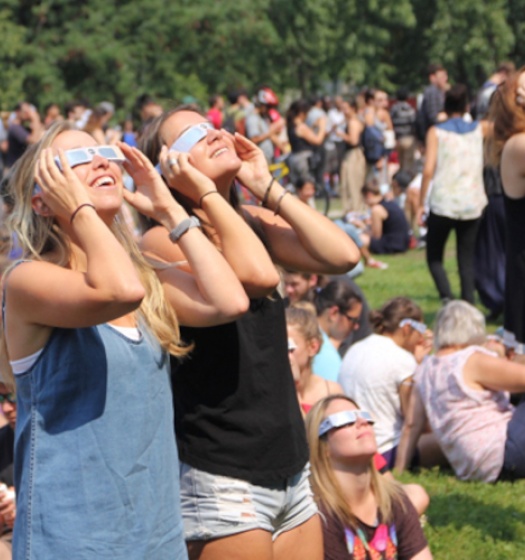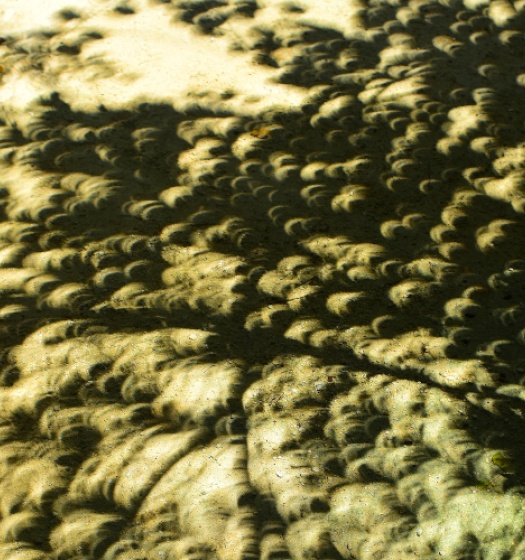On the afternoon of April 8, the moon will pass between the Earth and the sun, casting a shadow onto much of North America.
For observers who happen to be in the path of totality (the narrowest and darkest part of the shadow), the moon will completely obscure the sun and produce an awe-inspiring sight: a total solar eclipse.
Montreal is one of the lucky cities in the path of totality, which is only about 185 km wide and will cut diagonally across the continent from Mazatlán, Mexico to Newfoundland.
In preparation for this rare celestial event, McGill’s Trottier Space Institute (TSI) and the Department of Physics have organized a series of events and are inviting the public to explore the fascinating world of eclipses.
We sat down with TSI Director Victoria Kaspi and Earth & Planetary Sciences and Physics Professor Nicolas Cowan, both award-winning experts in their fields, to get their insights and advice on the upcoming eclipse.
We also got a sneak peek at McGill’s Eclipse Fair & Viewing Party from the event planning team, led by Carolina Cruz-Vinaccia (TSI), Hannah Fronenberg (TSI), and Srobona Basak (Physics).
This is a bucket-list event
Though a total solar eclipse happens about once every 18 months, it is extremely rare for any given location on Earth to experience one, explains Cowan, who recently gave a public talk about eclipses.
For Montreal, the last total solar eclipse was over 90 years ago and the next one after April 8 won’t take place until the early 2100s. (For other parts of Quebec, the interval between total solar eclipses is over 1,000 years.)
“You might feel like you have some really urgent deadline for work or school, but don’t miss this – this is once in a lifetime for most of us,” says Kaspi who, despite being a world-renowned astrophysicist, has not yet seen a total solar eclipse.
Both Kaspi and Cowan stress that, unless you’re an eclipse chaser who intentionally travels to prime viewing locations, this will likely be your only chance to witness a total solar eclipse.
The corona is the star of the show
“There are lots of astronomical events that people make a big deal about, but that are not a big deal,” says Cowan, pointing to what he feels is excessive hype around supermoons and lunar eclipses.
“A total solar eclipse is way better because you get to see the corona,” he says. The corona is the outermost layer of the sun’s atmosphere, which is made of plasma and is not usually visible to the naked eye.
During totality – when the sun is fully obscured by the moon – the corona will suddenly appear like “huge white flames emanating out of the sun,” explains Cowan.
“It looks really wild, and you start to understand why ancient people thought of the sun as a ball of fire,” he says.

The sun’s corona appearing at the moment of totality during a total solar eclipse.
Prepare for atmospheric changes
Eclipse watchers should also expect striking changes in brightness and temperature on April 8, according to Cowan.
“Towards the end of the partial eclipse, as the moon is marching across the disc of the sun, it'll be visibly darker,” says Cowan, adding that temperatures will drop and you might need to put on an extra sweater.
Once the eclipse hits totality, it will feel like nightfall but it won’t get completely dark. “It will be about as bright as a night with a full moon because of the corona.”
Eclipse glasses are a must
Kaspi recalls that a total solar eclipse took place in 1970 when she was a child, but she was forbidden from watching it because her mother had heard it was too dangerous.
“She insisted that we close all the curtains and blinds in our apartment, so I couldn't even tell that it got dark out,” says Kaspi. “I think I was sitting watching TV during the total solar eclipse when I was a little girl, which is kind of sad.”
Thanks to the growing popularity of eclipse glasses and the availability of information on the internet, eclipses are much safer than they used to be – if you take the right precautions.
“It’s important to understand that with proper eye protection, it's safe to look at the eclipse,” says Kaspi.
Unlike regular sunglasses, eclipse glasses are specially designed to block out almost all ultraviolet and infrared light and should be worn to look at the sun as soon as the eclipse starts.

About 3,000 people gathered on the Lower Field in 2017 to view the partial solar eclipse that was visible from Montreal.
McGill campus is the place to be
If you’re in Montreal and are looking for a place to observe the eclipse, the TSI has you covered. The Institute and the Physics Department are organizing an Eclipse Fair & Viewing Party on the Lower Field beginning at 1 p.m. on April 8. The event will be an opportunity for the McGill community and Montrealers to experience this historic moment together.
“This is just such an amazing event – you want to enjoy it with people and be part of a shared experience,” says Kaspi. “I definitely recommend people come down to campus.”
If conditions are clear, the eclipse should be visible from about 2 p.m. to 4:30 p.m., but totality will only last a minute and a half in Montreal starting at 3:26 p.m. (Keep your fingers crossed for a sunny day because the eclipse won’t be visible if it’s overcast, but the sky will still get dark.)
The event will feature activities, demos and booths for participants of all ages. This will include a pinhole camera crafting station for those who want to follow the eclipse’s progression without looking at the sun, and a “solar walk” that will allow attendees to visualize the scale of the solar system. Eclipse glasses will also be available for free on site.

In areas with leafy trees, sunlight filtering through the leaves will create a natural pinhole camera effect, projecting mini eclipses onto the ground. Pinhole cameras can also be made out of paper or cardboard.
The organizers have also planned collaborations with other units to explore not only the science of eclipses but also their historical impact (eclipses have halted and started battles in the ancient world), their cultural significance (they have inspired great works of art and literature), and their surprising zoological effects (they may cause animals to behave strangely).
“We couldn't do this without all the grad students and undergrads who volunteer,” says TSI Program Administrator Carolina Cruz-Vinaccia, who is the lead organizer of the event. “The only way outreach activities like this can run is because we have really enthusiastic students who want to share their knowledge with the public.”
Total solar eclipses will be impossible someday
One of the things Kaspi loves about total solar eclipses is how unlikely they are, astronomically speaking.
For a total solar eclipse to happen, the sun, moon and Earth need to be in perfect alignment, and the moon needs to be at the exact right distance from Earth to fully blot out the disc of the sun but not the corona.
If any one of these variables were different, total solar eclipses would not be possible. “It’s just pure coincidence. It absolutely did not have to be that way,” says Kaspi.
In fact, according to Cowan, total solar eclipses will eventually cease to exist because the moon is slowly moving away from us.
“Right now, we're in this happy place where, every once in a while, we get these perfect eclipses,” Cowan explains. But once the moon moves far enough away, it will appear too small in the sky to fully cover the sun, and only annular and partial eclipses will be possible.
Luckily this won’t happen anytime soon. Scientists predict that total solar eclipses will still be around for the next several hundred million years.
Science is for everyone
As with all of the Institute’s public outreach efforts, the TSI’s eclipse events are funded by the generous support of the Trottier Family Foundation.
“This eclipse has been marked on my calendar for years,” says Lorne Trottier, BEng’70, MEng’73, DSc’06, who established the Institute with a foundational gift in 2015 and made a historic $16-million donation to the TSI in 2022.
“A rare event like this is a prime opportunity, especially for young people, to get excited about science and the enormous potential for discovery in our universe,” Trottier says. “This is my fifth eclipse, and I can say from personal experience that this is truly one of the wonders of nature.”
Trottier has long held a passion for science outreach and it is something he wholeheartedly supports as a core tenet of the TSI’s mission.
“His philanthropy gives us the opportunity to do this kind of outreach, which not only educates the public but also educates scientists on how to go about presenting science. That is not something that is normally taught in graduate school, yet I am 100 percent convinced that it is crucial for science that we know how to effectively communicate,” says Kaspi.
“Receiving funding from someone like Lorne Trottier, who is deeply knowledgeable, really inspires us to find the most impactful ways we can use those resources.”
In addition to supporting the TSI’s eclipse event, the Trottier Family Foundation has also provided funding for Espace pour la vie Montréal to organize other eclipse events and educational activities in the city and helped fund the purchase of 500,000 eclipse glasses.

